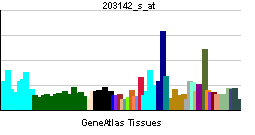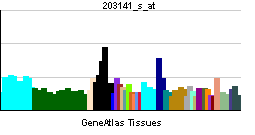AP3B1
| Adaptor-related protein complex 3, beta 1 subunit | |||||||||||
|---|---|---|---|---|---|---|---|---|---|---|---|
| Identifiers | |||||||||||
| Symbols | AP3B1 ; HPS; PE; HPS2; ADTB3; ADTB3A | ||||||||||
| External IDs | Template:OMIM5 Template:MGI HomoloGene: 68125 | ||||||||||
| |||||||||||
| RNA expression pattern | |||||||||||
 | |||||||||||
 | |||||||||||
| More reference expression data | |||||||||||
| Orthologs | |||||||||||
| Template:GNF Ortholog box | |||||||||||
| Species | Human | Mouse | |||||||||
| Entrez | n/a | n/a | |||||||||
| Ensembl | n/a | n/a | |||||||||
| UniProt | n/a | n/a | |||||||||
| RefSeq (mRNA) | n/a | n/a | |||||||||
| RefSeq (protein) | n/a | n/a | |||||||||
| Location (UCSC) | n/a | n/a | |||||||||
| PubMed search | n/a | n/a | |||||||||
Adaptor-related protein complex 3, beta 1 subunit, also known as AP3B1, is a human gene.[1]
This gene encodes a protein that may play a role in organelle biogenesis associated with melanosomes, platelet dense granules, and lysosomes. The encoded protein is part of the heterotetrameric AP-3 protein complex which interacts with the scaffolding protein clathrin. Mutations in this gene are associated with Hermansky-Pudlak syndrome type 2.[1]
References
Further reading
- Huizing M, Gahl WA (2003). "Disorders of vesicles of lysosomal lineage: the Hermansky-Pudlak syndromes". Curr. Mol. Med. 2 (5): 451–67. PMID 12125811.
- Maruyama K, Sugano S (1994). "Oligo-capping: a simple method to replace the cap structure of eukaryotic mRNAs with oligoribonucleotides". Gene. 138 (1–2): 171–4. PMID 8125298.
- MacNeill SA, Nurse P (1993). "Genetic analysis of human p34CDC2 function in fission yeast". Mol. Gen. Genet. 240 (3): 315–22. PMID 8413179.
- Simpson F, Peden AA, Christopoulou L, Robinson MS (1997). "Characterization of the adaptor-related protein complex, AP-3". J. Cell Biol. 137 (4): 835–45. PMID 9151686.
- Dell'Angelica EC, Ooi CE, Bonifacino JS (1997). "Beta3A-adaptin, a subunit of the adaptor-like complex AP-3". J. Biol. Chem. 272 (24): 15078–84. PMID 9182526.
- Suzuki Y, Yoshitomo-Nakagawa K, Maruyama K; et al. (1997). "Construction and characterization of a full length-enriched and a 5'-end-enriched cDNA library". Gene. 200 (1–2): 149–56. PMID 9373149.
- Dell'Angelica EC, Klumperman J, Stoorvogel W, Bonifacino JS (1998). "Association of the AP-3 adaptor complex with clathrin". Science. 280 (5362): 431–4. PMID 9545220.
- Feng L, Seymour AB, Jiang S; et al. (1999). "The beta3A subunit gene (Ap3b1) of the AP-3 adaptor complex is altered in the mouse hypopigmentation mutant pearl, a model for Hermansky-Pudlak syndrome and night blindness". Hum. Mol. Genet. 8 (2): 323–30. PMID 9931340.
- Dell'Angelica EC, Shotelersuk V, Aguilar RC; et al. (1999). "Altered trafficking of lysosomal proteins in Hermansky-Pudlak syndrome due to mutations in the beta 3A subunit of the AP-3 adaptor". Mol. Cell. 3 (1): 11–21. PMID 10024875.
- Huizing M, Scher CD, Strovel E; et al. (2002). "Nonsense mutations in ADTB3A cause complete deficiency of the beta3A subunit of adaptor complex-3 and severe Hermansky-Pudlak syndrome type 2". Pediatr. Res. 51 (2): 150–8. PMID 11809908.
- Feng L, Novak EK, Hartnell LM; et al. (2002). "The Hermansky-Pudlak syndrome 1 (HPS1) and HPS2 genes independently contribute to the production and function of platelet dense granules, melanosomes, and lysosomes". Blood. 99 (5): 1651–8. PMID 11861280.
- Kim YM, Barak LS, Caron MG, Benovic JL (2002). "Regulation of arrestin-3 phosphorylation by casein kinase II". J. Biol. Chem. 277 (19): 16837–46. doi:10.1074/jbc.M201379200. PMID 11877451.
- Dubois T, Howell S, Zemlickova E, Aitken A (2002). "Identification of casein kinase Ialpha interacting protein partners". FEBS Lett. 517 (1–3): 167–71. PMID 12062430.
- Strausberg RL, Feingold EA, Grouse LH; et al. (2003). "Generation and initial analysis of more than 15,000 full-length human and mouse cDNA sequences". Proc. Natl. Acad. Sci. U.S.A. 99 (26): 16899–903. doi:10.1073/pnas.242603899. PMID 12477932.
- Salazar G, Love R, Werner E; et al. (2004). "The zinc transporter ZnT3 interacts with AP-3 and it is preferentially targeted to a distinct synaptic vesicle subpopulation". Mol. Biol. Cell. 15 (2): 575–87. doi:10.1091/mbc.E03-06-0401. PMID 14657250.
- Gerhard DS, Wagner L, Feingold EA; et al. (2004). "The status, quality, and expansion of the NIH full-length cDNA project: the Mammalian Gene Collection (MGC)". Genome Res. 14 (10B): 2121–7. doi:10.1101/gr.2596504. PMID 15489334.
- Guinn BA, Bland EA, Lodi U; et al. (2005). "Humoral detection of leukaemia-associated antigens in presentation acute myeloid leukaemia". Biochem. Biophys. Res. Commun. 335 (4): 1293–304. doi:10.1016/j.bbrc.2005.08.024. PMID 16112646.
- Rual JF, Venkatesan K, Hao T; et al. (2005). "Towards a proteome-scale map of the human protein-protein interaction network". Nature. 437 (7062): 1173–8. doi:10.1038/nature04209. PMID 16189514.
- Jung J, Bohn G, Allroth A; et al. (2007). "Identification of a homozygous deletion in the AP3B1 gene causing Hermansky-Pudlak syndrome, type 2". Blood. 108 (1): 362–9. doi:10.1182/blood-2005-11-4377. PMID 16537806.
| This protein-related article is a stub. You can help Wikipedia by expanding it. |